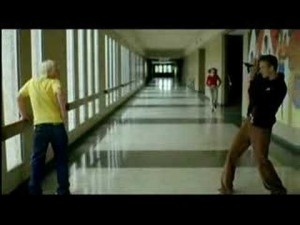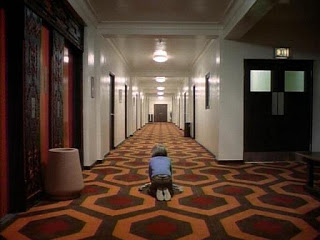From the Chicago Reader (November 7, 2003). — J.R.
 |
Elephant
**** (Masterpiece)
Directed and written by Gus Van Sant
With Alex Frost, Eric Deulen, John Robinson, Elias McConnell, Jordan Taylor, Carrie Finklea, Nicole George, Brittany Mountain, Bennie Dixon, Nathan Tyson, Alicia Miles, Kristen Hicks, Timothy Bottoms, and Matt Malloy.
Gus Van Sant’s startling and brilliant Elephant — a film that follows the activities of several high school students before and during a massacre like the one at Columbine — has its flaws, yet its virtues so outshine them that the years he’s spent lost in the wilderness can be forgiven. His four previous features weren’t exactly dead on arrival, though his 1998 remake of Psycho came alarmingly close. But the filmmaker responsible for such fresh early shorts as The Discipline of DE (1978) and My New Friend (1987) and such exciting early features as Mala Noche (1985), Drugstore Cowboy (1989), and My Own Private Idaho (1990) was almost nowhere in evidence in Good Will Hunting (1997), Psycho, or Finding Forrester (2000) and only faintly discernible in the experimental feature Gerry (2001). (In between were two satirical features, the uneven 1993 Even Cowgirls Get the Blues and the more successful 1995 To Die For.)
Good Will Hunting, Van Sant’s first big commercial success, was a borderline sellout, and Finding Forrester was almost a complete one. But then came Gerry, as if to prove he was still willing to take big risks. He also started saying he’d been inspired to take those risks by such worthy role models as Chantal Akerman, James Benning, Andrei Tarkovsky, Bela Tarr, and Jacques Tati — though the evidence of their influence wasn’t discernible, apart from an increased use of landscapes and long takes.
In contrast, two of the major influences on Elephant are plainly visible. From Tarr’s Satantango (1994) comes a complicated overlapping time structure that repeats the same events from a variety of viewpoints, seen mainly in extended takes that follow characters as they walk through adjacent settings. (Stanley Kubrick’s 1956 The Killing also repeats the same events from disparate viewpoints, but with offscreen narration and without all the walking and intersecting trajectories.) From Kubrick’s The Shining (1980) comes the traversal of endless hallways, a sense of impending menace and bloodshed, a black male calmly and methodically coming to the rescue of those in danger until he’s abruptly thwarted, and a food locker used as a place to hide.

Van Sant has so thoroughly assimilated these influences he can’t be accused of simple imitation. Elephant is neither an interim report on the state of humanity like Satantango nor a horror story like The Shining, though it has traces of both. It was generated largely by talking to the high school students who were cast and shaping their parts on the basis of what they said about their own lives. Apparently none of the dialogue was scripted, and the first ten cast members listed at the head of this review all used their own first names in the film.
The two main lessons Elephant has to impart are both suggested by its title, which Van Sant has indicated was inspired by Alan Clarke’s 1989 BBC film of the same name about violence in Northern Ireland. Van Sant says he originally thought Clarke’s title referred to the parable about several blind men trying to describe an elephant and each one drawing a different conclusion based on which body part he was touching. He later discovered that Clarke was actually thinking of a saying about a problem being as easy to ignore as “an elephant in a bedroom.” The problems of high school students may be as hard to ignore as an elephant in a bedroom, but they’re also as easy to misperceive as an elephant being examined by blind men.
To understand how these two propositions play out in the film it’s important to know that Van Sant has no better notion of why the Columbine massacre occurred than anyone else. All he has are a few wild guesses — some more plausible than others, none remotely conclusive — and most of the film’s flaws can be traced back to those guesses, which take up far more of our attention than they deserve. Some of the pointedly yet inadequately suggestive details include a nasty classroom prank, a video game, a documentary about Nazism seen on TV, a kiss and an embrace between the two killers in a shower, and the Moonlight Sonata, which is played on-screen and heard offscreen during other sequences.
Van Sant is interested mainly in why such massacres aren’t anticipated and what that tells us about the climate in which they occur. This is precisely where the methodology of Satantango becomes crucial, because each time we follow a different character and brush past the same events from a different angle, we see things we didn’t see before and we’re made to understand that the way we focused on previous narratives helped to blind us. The subject of the film, in short, is what we miss — and keep missing, regardless of how alert we are to the action we’re following. Each character is a separate story, and the event as a whole is gradually revealed as unfathomable because we can’t follow one story without partially overlooking others the film grazes. Watching the film a second time, I still didn’t catch bits of dialogue a friend pointed out afterward, and he probably missed some of the details I noticed.
Since most of the film’s events are realistic and believable, the few that aren’t register as lapses. Overall Van Sant is less sensitive toward the girls than he is toward the boys, and in the case of Brittany, Jordan, and Nicole — three friends we always see together — his treatment is crudely parodic. It’s bad enough that all three girls are shown entering toilet stalls to chuck up the lunch they’ve just eaten; that they were given less than two minutes to consume that lunch — while the camera drifted around their table and turned to peer out the window, during the last part of what is probably the most elaborately and impressively choreographed shot in the film — makes the conceit even more ludicrous.

Last week someone expressed disagreement when I wrote, referring to biopics in general and Sylvia in particular, that “people’s lives aren’t stories.” I might have added by way of explanation that a third of our lives is spent sleeping and much of the rest is devoted to things not ordinarily included in stories either: going to the toilet, reading, scratching ourselves, eating lunch. When novelists and filmmakers allude to such activities they do so selectively. In Ulysses James Joyce tried to deal with one day in the waking life of one person more comprehensively, but many readers find the plethora of details so overwhelming that the overarching story gets lost. Yet even Joyce’s story is made up of selected details — all lives have to be edited if they’re going to be shaped into stories.
By design, the stories in Elephant are all far from complete. In some cases death ends them abruptly. In other cases we follow the lives of characters over at most a few hours. We’re also catching the trajectories of all of them piecemeal, in installments, which occasionally leaves continuity gaps that are never filled. Moreover, most of the incidents are relatively banal, though some of them gain resonance retroactively.
In the opening sequence John is introduced with an intertitle bearing his name. His drunken father (Timothy Bottoms) is driving him back to school after lunch, and John takes over the wheel. Another introductory intertitle shifts us to Elias, who’s photographing a couple in a park. Then we return to John parking, asking his father to stay in the car, entering the school building, and calling his brother Paul (whom we never see) on a pay phone to say their father is drunk. John is then summoned to the principal’s office for being late. We shift to the athletic field, where we see Michelle and then Nathan, who’s followed for some distance until he meets his girlfriend Carrie. At which point we return to John in the principal’s office and follow him as he leaves the car keys with a school employee for Paul to pick up later. Only after he enters a large common room do we suddenly notice that he’s crying — and we may realize this only because a girl asks him what’s wrong and kisses him gently on the cheek. It’s one of the few moments of tenderness in the film, but we quickly leave John to follow the girl to class.

The fleeting details of these segments and the nearly constant changes of light beautifully captured by Harris Savides’s cinematography create a sense of continual flux. On a few occasions the camera pans from one character to another, but it tends to stay with single characters, fostering the impression that strands are being woven into a single narrative tapestry and implying that we’ll eventually wind up with a lucid overall picture. But we never see enough to take in the whole action, and adding up what we do see doesn’t yield a global picture. Much of the action occurs offscreen, and we miss things by being with just one character most of the time. As in Satantango, this method tends to implicate us morally along with whomever we’re following, whether we like them or not, because we stay with them for so long.
The immediate source of Elephant‘s narrative structure is Tarr’s film, and Tarr took his structure from a Hungarian novel by Laszlo Krasznahorkai. I would guess that Krasznahorkai got his structure, which resembles William Faulkner’s in Light in August, from Joseph Conrad novels such as Nostromo (also Faulkner’s likeliest source). Like a cubist painting, this structure builds a three-dimensional world in layers, but since our moment-to-moment experience of the work is both confined and linear, we’re constantly being brought up short as we’re alerted to details we missed in the previous layer.
This sense of incompleteness mirrors the way historical events are interpreted and reinterpreted. Two other films showing this week examine perspectives missed in the reporting of important historical events when they happened. Brother Outsider: The Life of Bayard Rustin, a documentary showing at the lesbian and gay international film festival, explores the various ways in which Rustin — in some ways the most intelligent and charismatic leader in the civil rights movement and a pacifist mentor to Martin Luther King Jr. — gradually became marginalized and disempowered by conservatives who despised him for being openly gay and leftists who despised him for deciding to work within the existing power structure. I met Rustin briefly in the 60s and couldn’t understand why he dropped from sight at the height of his influence until I saw this documentary. The Year That Trembled, a Jay Craven fiction film set in the early 70s that’s showing at the Gene Siskel Film Center, both clarified and complicated my view of the 1970 Kent State killings by exposing the substantial role played by FBI agents posing as radicals — whose violent acts may have partially instigated those killings.

In both cases I had missed basic facts, which were kept from my view because they didn’t fit the ruling narratives of the time. In Elephant I missed facts — admittedly elusive and likely to shift from one viewing of the film to the next — largely because of the film’s formal structure, though that structure implies a great deal about how ruling narratives are created. Van Sant’s way of telling and not telling his story helps explain how a problem as obvious as an elephant in a bedroom can’t be recognized if we’re so blinded by agendas that we can size up the animal only one piece at a time.






